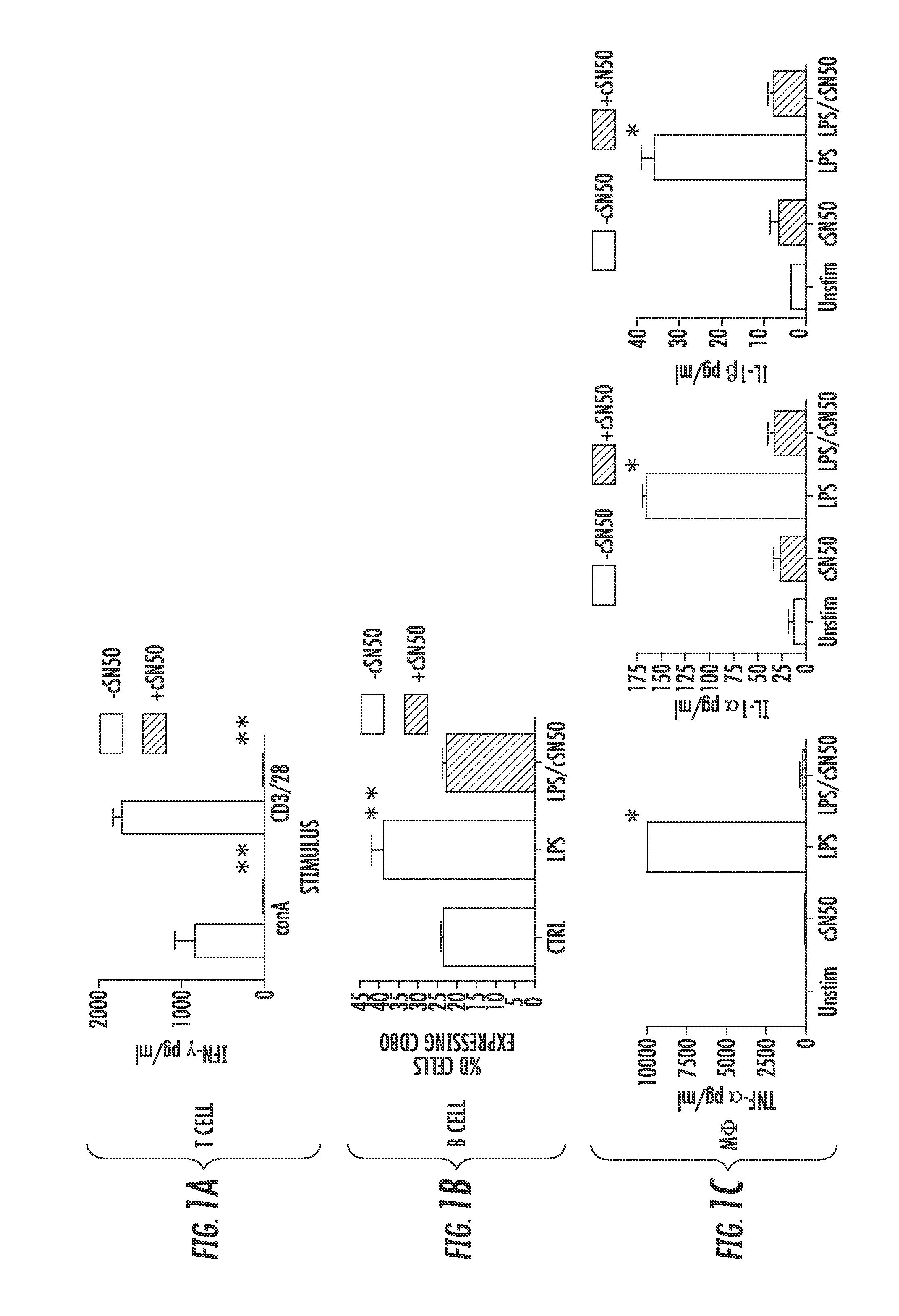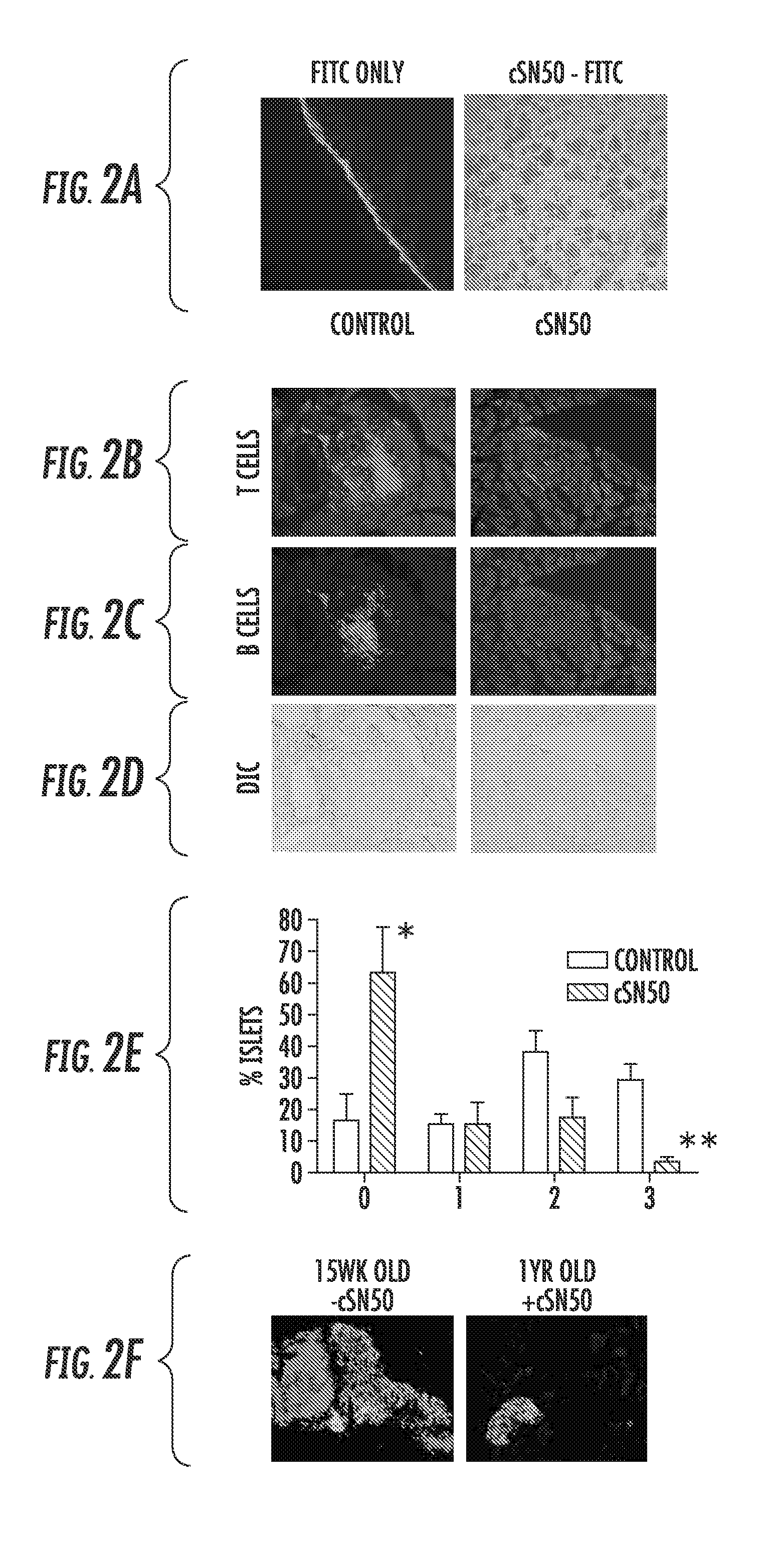Compositions for preserving insulin-producing cells and insulin production and treating diabetes
a technology of insulin-producing cells and compositions, applied in the field of endocrinology, immunology, cell biology, can solve the problems of limited success rate of approaches, patients face life-long risks of cardiovascular and renal diseases, complications, and blindness, and achieve the effects of preserving residual insulin-producing capacity, reducing accumulation of islet-destructive autoreactive b, and enhancing activation-induced cell death
- Summary
- Abstract
- Description
- Claims
- Application Information
AI Technical Summary
Benefits of technology
Problems solved by technology
Method used
Image
Examples
example 1
Mice and Diabetes Monitoring
[0086]NOD / LtJ, NOD-BDC2.5 and C57BL / 6 mice were purchased from the Jackson Laboratories (Bar Harbor, Me.) at 6-8 weeks of age. All mice were housed and maintained according to the guidelines for use and care of laboratory animals as set forth by Vanderbilt University and regulated via the Vanderbilt IACUC. All NOD mice were monitored twice weekly for the development of diabetes by blood glucose measurement with FreeStyle® FastTake test strips (Abbott Laboratories, Abbott Park, Ill.). Two consecutive glucose measurements >220 mg / dl constituted a diagnosis of diabetes. A colony of NOD mice kept by a collaborating laboratory in the same animal suite has a spontaneous diabetes incidence of 80-90% in females by 30 weeks of age indicating an animal environment that is conducive for diabetes development.
[0087]Isolation of lymphoid cells and preparation of bone marrow derived macrophages
[0088]Splenocytes and lymph node cells were prepared by dispersion of the org...
example 2
[0113]Primary lymphocytes and macrophages from NOD mice are susceptible to attenuation of T cell receptor (TCR)- and Toll-like receptor (TLR)-evoked pro-inflammatory signaling, respectively, by a Nuclear Transport Modifier. NOD mice, a widely used model of human T1D, demonstrate genetic predisposition toward autoimmune diabetes as evidenced by numerous immunologic abnormalities of innate and adaptive immunity as compared to normal strains of mice. The Nuclear Transport Modifier, cSN50 peptide, attenuates TCR- and TLR-evoked cytokine / chemokine production in murine models of acute inflammation and apoptosis using normal C57BL / 6 and BALB / c strains (Lin et al (1995) Inhibition of nuclear translocation of transcription factor NF-kappa B by a synthetic peptide containing a cell membrane-permeable motif and nuclear localization sequence. J Biol Chem 270: 14255-14258; Hawiger J (1999) Current Opinion in Chem. Biology 3:89-94; Liu et al. (2000) J Biol Chem 275: 16774-16778; Liu et al. (2004)...
example 3
[0118]Intracellular delivery of a Nuclear Transport Modifier to the pancreas reduces islet inflammation (insulitis). The highly effective suppression of pro-inflammatory and pro-apoptotic cytokines in ex vivo analysis of primary, NOD-derived immune cells following treatment with cSN50 peptide encouraged in vivo study of Type 1 diabetes in NOD mice. It was first determined whether cSN50 would be delivered to the pancreas, the primary site of autoimmune attack against beta cells in pancreatic islets. It was demonstrated that this cell-penetrating Nuclear Transport Modifier peptide is delivered to blood leukocytes / lymphocytes, spleen, liver, and lung to suppress acute liver and lung inflammation (Lin et al. (1995) J Biol Chem 270: 14255-14258; Liu et al. (2000) J Biol Chem 275: 16774-16778; Liu et al. (2009) Mol Ther 17: 796-802). Using confocal microscopy, the pancreatic delivery of FITC-labeled cSN50 peptide following a single intraperitoneal (i.p.) injection was assessed. Rapid and ...
PUM
| Property | Measurement | Unit |
|---|---|---|
| Transport properties | aaaaa | aaaaa |
Abstract
Description
Claims
Application Information
 Login to View More
Login to View More - R&D
- Intellectual Property
- Life Sciences
- Materials
- Tech Scout
- Unparalleled Data Quality
- Higher Quality Content
- 60% Fewer Hallucinations
Browse by: Latest US Patents, China's latest patents, Technical Efficacy Thesaurus, Application Domain, Technology Topic, Popular Technical Reports.
© 2025 PatSnap. All rights reserved.Legal|Privacy policy|Modern Slavery Act Transparency Statement|Sitemap|About US| Contact US: help@patsnap.com



